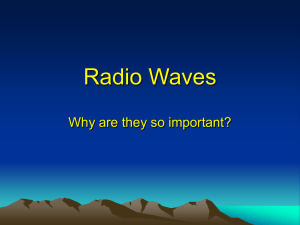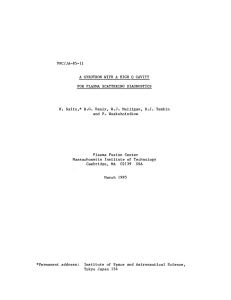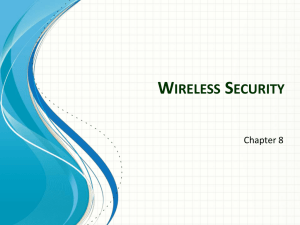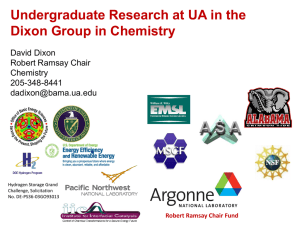Gyrotrons for plasma experiments - historical overview (EC-17).
advertisement
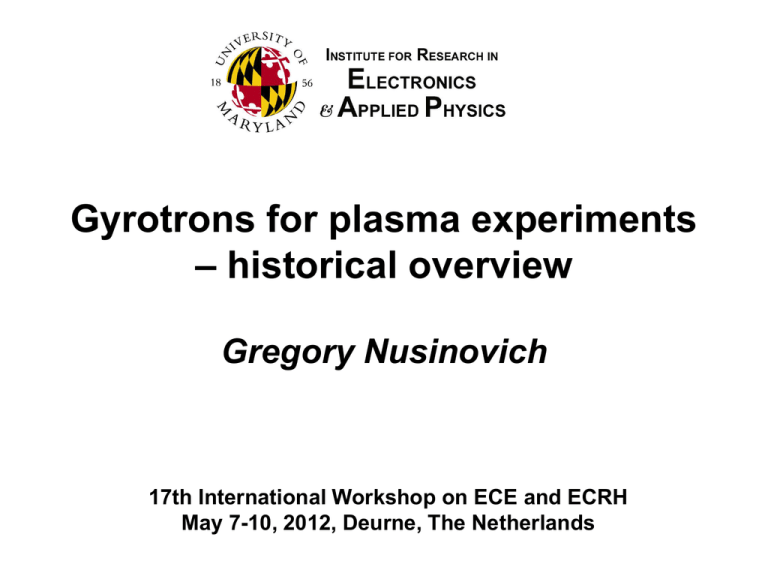
Gyrotrons for plasma experiments – historical overview Gregory Nusinovich 17th International Workshop on ECE and ECRH May 7-10, 2012, Deurne, The Netherlands Contents • • • • • • Discovery of the cyclotron maser instability First experiments From a CRM to gyrotrons First experiments on ECRH Built-in quasi-optical mode converters Gyrotron “resonance” – success of gyrotron development and ECRH experiments in the USSR initiates the gyrotron development in many countries (USA, France, Germany, Japan). • Varian CW gyrotrons Contents (cont.) • Late 1970’s – first experiments on ECRH in many countries (USA, Germany, UK, Japan). • 1980’s – gyrotron “maturity” (higher power, higher frequencies, longer pulses/CW). • 1990’s – CVD diamond windows pave the way to CW MW operation • 2000’s – MW CW gyrotrons for ITER (K. Sakamoto et al, GYCOM, EU) • Plasma applications: preionization, ECRH, ECCD, suppression of NTMs, collective Thomson scattering • Conclusions Cyclotron maser instability • R. Q. Twiss “Radiation transfer and the possibility of negative absorption in radio astronomy”, Australian Journal of Physics, v. 11, 567-579 (Dec. 1958). • Jurgen Schneider, “Stimulated emission of radiation by relativistic electrons in a magnetic field”, PRL, v. 2, 504-505 (June 15, 1959). • A. V. Gaponov, “Interaction between electron fluxes and electromagnetic waves in waveguides”, Izv. VUZov Radiofizika, v. 2, 450-462 (March 1959); “Addendum” (Oct. 1959, thanks to V. Zheleznyakov) Cyclotron maser instability • Twiss: Two conditions for instability of EM waves in magnetoactive plasma: - population inversion f / E 0 - stimulated transition probability Q / E 0 Schneider: stimulated emission is possible when the electron interaction time is long enough: T E 1 2 mc Figure 1. Cyclotron resonance absorption of a non-relativistic (A) and a relativistic (B) electron. The kinetic electron energy in the latter case is 76 eV. The interaction time is close to 1600 wave periods. J. Schneider, PRL, 1959 Cyclotron maser instability • Gaponov: first paper - the instability caused by axial electron bunching (Weibel did the same in 1959). Addendum - after his discussions with V. V. Zheleznyakov, Gaponov realized that the relativistic dependence of electron cyclotron frequency on electron energy leads to the orbital bunching, the effect of the same order as the axial bunching G z , s G ,s k / c k z / c - two bunching mechanisms in ensemble of 2 2 2 2 2 z 2 electrons cancel each other (Gaponov, 1960). Autoresonance for a single electron was discovered a few years later (Davydovskiy, 1962; Kolomenskiy and Lebedev, 1963) First experiments • R. H. Pantell, “The Cyclotron Resonance Backward-Wave Oscillator”, 1959-1960. • I. I. Antakov, Experiments with electron phase selection in a beam propagating close to the metallic wall (unpubl.) • I. Bott, “Tunable source of mm and sub-mm electromagnetic radiation”, Proc. IEEE (1964) • R. L. Schriever and C. C. Jonson, Proc. IEEE (1966) • In all those cases, the cyclotron maser instability was not understood. Rather, some authors referred to the axial bunching. • H. Alfven (1954), Agdur (1957) – two mechanisms of coherent radiation (sorting out and E ) • Experiments with correct interpretation were reported by Gaponov (1959) and Hirshfield with Wachtel (PRL, 1964). • Gaponov in 1959 reported about an experiment with a CRMamplifier operating with a positive electronic gain. From CRM to gyrotrons • Gaponov’ group: to produce efficient, high-power millimeter-wave radiation it is necessary to have (a) an intense electron beam with a large orbital-to-axial velocity ratio and a small spread in velocities, (b) an oversized circuit without small-scale elements for avoiding RF breakdown. Petelin, Goldenberg, Gaponov formulated the requisites: - magnetron-type electron gun producing intense beams, - adiabatic compression of a beam in the region between the gun and the interaction circuit, - an oversized smooth-wall waveguide with a cutoff narrowing at the entrance and an open end at the exit – diffraction output, - operation near cutoff reduces the inhomogeneous Doppler broadening of the cyclotron resonance and, hence, mitigates the effect of electron axial velocity spread on the beam-wave interaction. k z v z s From a CRM to gyrotrons • • • • • • LAYOUT OF THE FIRST GYROTRON design started at the end of 1963: open cavity of rectangular cross section, operating mode , diffraction output of RF power, magnetron injection (triode) gun, glass insulation, water cooled solenoid. tested September 1964 10 GHz /6 W CW V. K. Yulpatov developed the generalized linear and nonlinear theory of CRMs and, in particular, gyrotrons. By the end of 1960s the gyrotron power at long millimeter wavelengths reached a 100 kW power level in millisecond pulses. This accomplishment allowed one to expect significant rise in electron plasma temperature due to absorption of a multi-Joule, mm-wave energy. First experiments on ECRH with gyrotrons • Moscow (Kurchatov Institute, tokamak TM-3, V. V. Alikaev et al., JETP Lett, vol. 15, 41-45, 1972) • Leningrad (Ioffe Institute, Tuman-2, V. E. Golant et al., J. Techn. Phys., vol. 42, 620-628, 1972). - TM-3: the gyrotron was made at the Radiophysical Research Institute, Gorky, (wavelength about 1 cm, power 40 kW, pulse duration 0.5 msec); electron temperature was almost doubled (initial T – 250 eV), the efficiency of ECRH – 20-30%. - Tuman-2: the gyrotron was fabricated at “Salut”, Gorky, (34 GHz, Pin=30 kW, pulse duration 0.1 msec); HHRH, efficiency less than 10%. Gyrotrons for ECRH in mid- and late-70’s • 1975, Flyagin, Luchinin, Ofitserov, Pankratova: frequency near 70 GHz, output power – 80-100 kW, pulse duration less than 1 msec. • Continuing experiments on TM-3 during mid-1970’s stimulated the start of gyrotron development in other countries (USA, France) Efficiency (Nusinovich, Erm, 1972) These plots were used for designing all Soviet gyrotrons In 1970-1980’s. (B. Danly, R. Temkin, 1986) K. Kreischer and R. Temkin, “Infrared and Millimeter Waves”, vol. 7, Academic Press, 1983 Gyrotrons for plasma heating (late 1970s) Soviet long-pulse Alikaev, Flyagin, Khizhnyak, Luchinin, gyrotron, 86 GHz, st 300 kW, TE9,2-mode Nusinovich, Usov, 1 Symp., Grenoble, 1978, top – 100 GHz, 1 MW, TE22,2-mode Varian 28 GHz gyrotron: 250 kW pulse, 105 kW CW, TE0,2-mode H. Jory, Grenoble, 1978 Higher power – higher-order modes! • ECRH: higher power, higher frequencies, longer pulses! 2 max Pmax pohm m2 , p m2 5/2 L Higher-order modes! Mode competition. Theory of mode interaction was in focus starting from 1974 (Nusinovich with co-workers). Many of those results were reproduced in 1980’s and later by other scientists. Start-up Scenario • When the beam voltage rises from 0 to its nominal value (80-100 kV) the electron cyclotron frequency varies by 15-20%! • In the case of dense frequency spectrum, many modes can be excited during the voltage rise. Low-order modes (Borie et al., 1992) Nusinovich, 1974 (see also, D. Whaley et at, PRL, 1995) K. Sakamoto, 2011 Evolution of operating modes TE0,2 D / 2.2 TE15,4 D / 10 TE22,6 D / 15 TE31,8 or TE25,10 D / 20 Example: 1975-6, the goal - to develop a 1 MW gyrotron at 100 GHz! The choice of the operating mode. Previous experiments (1972-3) with a 1 MW short-pulse 45 GHz gyrotron operating in TE15,1-mode (Omega) showed that stable operation can be achieved only in coaxial cavities. What to choose: m=10? m=15? m=20? Gaponov’s decision. In 1978, the realization of 1 MW in a 100 GHz gyrotron was demonstrated (TE22,2)! Gyrotrons with built-in quasi-optical mode converters To tolerate thermal loading, collectors/waveguides should have large dimensions. When the waveguide diameter Is much larger than the resonator diameter, the waves propagate at small Brillouin angles. After such waves exit through the window, one should convert them into Gaussian wave beams with linear polarization. Such converters are very large. M. I. Petelin: Mode conversion in Gaussian wave beams inside gyrotrons! Flyagin and Nusinovich, Proc. IEEE, vol. 76, 644 (1988) Quasi-optical mode converters • Converters of TE0p- and TE1,p - modes into wave beams (Vlasov and Orlova, 1974) • Converters of WGM (m>>p) into wave beams (Vlasov, Zagryadskaya and Petelin, 1975). Efficiency<80%. • Much later, dimpled-wall converters with the efficiency over 90% were proposed (G. Denisov, 1992) Preparation of a wave beam in a waveguide Soviet gyrotron team in 1970’s-1980’s (gyrotrons for ECRH) • Flyagin, Luchinin, Khiznyak, Venediktov, Likin, Vlasov, Nusinovich, Usov –IAP • Bogdanov, Kurbatov – Salut • ECRH in T-10 1982: 83 GHz, 200 kW, 0.1 sec; Pin=0.7 MW 83 GHz, Pin=700 kW, 100 ms ECH efficiency – 90% A. Litvak, E. Suvorov (1977) – O-wave heating! Also, V. Parail, V. Alikaev. Gyrotrons for plasma experiments in tokamaks and stellarators • • • • Pre-ionization and pre-heating, Local heating and profile control, Bulk heating, Non-inductive current drive J. Rager, “European Fusion Programme”, Int. J. Electronics (1984) 1980’s – gyrotrons in the US, France, Germany and Japan • Varian: long-pulse and CW gyrotrons K. Felch, H. Huey and H. Jory, Journal Fusion Energy, vol. 9, 59 (1990) 1980 – 28 GHz, 212 kW CW 1981 – 60 GHz, 200 pulsed (TE0,2) 1984 – 60 GHz, 200 kW CW 52, 56 and 70 GHz gyrotrons were quite similar (developed in parallel with 60 GHz tubes) 35 GHz gyrotron operated in the TE0,1 1986 – 140 GHz, 100 kW CW (TE0,3) 1988 – 70 GHz gyrotrons for WVII-AS 106 GHz – second harmonic gyrotron for Kyoto Heliotron Center (TE0,3) More than 100 gyrotrons were delivered to various plasma labs: JFT-2 (JAERI), Heliotron (Japan), TMX-U (Livermore), TRW and CLEO (Culham), Milano University, EBT (Oak Ridge), Doublet III, PDX (PPPL) 1980’s – gyrotrons in the US • MIT: concepts of high-frequency, high-power gyrotrons (R. Temkin, K. Kreischer) – short pulse experiments,140 GHz,175kW operation at various modes; later (PRL,1987) – up to 0.6 MW (TE15,2), frequencies from 120 GHz to 250 GHz. • Hughes Aircraft (Tancredi, Ferguson) - 60 GHz, 285 kW, 44%, long pulses ∙ NRL: 35 GHz and 120 GHz gyrotrons; at 120 GHz – complex cavity – 350 kW, 63%, Quasi-optical gyrotrons. NRL developed the first US gyrotron used for ECRH at ISX-B tokamak. 1980’s – gyrotrons in Europe • Thomson-CSF (presently, Thales) – G. Mourier: - TH 1502: 35 GHz, up to 300 kW in long (0.1 s) pulses (TE0,2); 70 GHz at the second cyclotron harmonic - TH 1503: 100 GHz, 200 kW in long (0.1 s) pulses (TE0,2/TE0,4- step-profile cavity) -TH 1504: 8 GHz, 0.5-1.0 MW, 1 sec (TE5,1) – for LHH in FTU (Frascati) - TH 1505: 110 GHz, 200-400 kW (TE6,4) – for ToreSupra (Cadarache) ∙ KfK (Germany): 150 GHz, 280/150 kW (1/100 ms) ∙ CRPP (Lausanne, Swiss) : 120 GHz, 200 kW, 100 ms ∙ Valvo (Hamburg, Germany): 70 GHz, 200 kW, 38% (0.1 s). Behm, Jensen First French gyrotron: TH 1501 A, 35 GHz, 230 kW, TE0,2-mode, short pulse. 1980’s – gyrotrons in Japan Toshiba: 22 GHz, 28 GHz, 70 GHz. - 22 GHz, TE0,1-mode, 40 kW, 40% eff. - 70 GHz, TE0,2-mode, 25 kW, 30% eff. - 28 GHz, TE0,2-mode, 230 kW, 30% eff Mitsubishi: 120 GHz, TE0,3,170 kW, 25% ECRH experiments in the US • NRL (M.Read, V. Granatstein et al., 1979-1980). 35 GHz, 100 kW, 10 ms gyrotron. ∙ First experiments on ECRH were carried out at ISX-B tokamak (R. Gilgenbach et al, PRL, 1980) Doublet-III (R. Prater et al., 1984-85) O- and X-wave heating, 60 GHz, 450-600 kW For a long time, Doublet III-D remains the most important plasma installation for gyrotron use in ECRH/CD experiments in the US (110 GHz, 1 MW, 10 s). At present, 6 gyrotrons are in use (J. Lohr and his team) ISX-B, X-wave heating Gilgenbach et al Output windows • In the 1990’s, the gyrotron progress in increasing the mm-wave energy per pulse (power and pulse duration) was limited by available output windows at about 1 MJ level (200-300 kW/5 sec or 1 MW/1 sec). • Various materials (sapphire, boron nitride, silicon nitride) and various methods of cooling (edge-cooled, surface-cooled, gas and liquid cooling), room-, LN2-, LHe-temperature regimes were tested. • CVD diamond windows with their combination of a reasonably low loss tangent with a superior thermal conductivity led to a breakthrough in this situation. • Only the use of CVD diamond windows made the development of MW-class, CW gyrotrons possible! (albeit, quite expensive). (Grenoble – cost analysis) Gyrotrons in ‘museums’ From left to right: - Varian 28 GHz, 200 kW CW - GYCOM 140 GHz, 700 kW, 3 sec, -Varian 60 GHz, 200 kW pulsed -- GYCOM 140 GHz, 500 kW, 0.5 sec Gyrotron history at IPF, Greifswald From V. Zapevalov (2011) MW Gyrotrons today From K. Sakamoto, Fusion Science and Technology, 2007 Japan:TE31,8 Russia: TE25,10 EU: TE34,19-coax 170 GHz gyrotrons for ITER US: TE28,7-mode EU: TE28,8-mode 140 GHz gyrotrons for W7-X Gyrotron codes for designing MW-class, CW gyrotrons • Self-consistent, non-stationary, parameterized code MAGY (UMD/NRL, T. Antonsen and coworkers). • Example: start-up scenario in a 140 GHz, 1 MW CPI gyrotron for ECRH/CD in W7-X. Nusinovich, Sinitsyn, Velikovich et al., IEEE-PS, 2004 Manipulation with gyrotron parameters: start-up scenario, suppression of NTMs • • To avoid excitation of spurious modes we need a proper start-up scenario which becomes more and more complicated as we move towards higher and higher-order modes. Example: for operation at more than MW level continuously we should have modes with a large radial index (presently, TE31,12). A high current beam injected in the region of maximum coupling to such modes has the current exceeding the space-charge limiting current. Ions can neutralize the beam space charge in less than 100 msec. Two-step process. Space-charge limiting current depends on electron axial velocity. Stability of theTE31,20 mode • No growth of satellites at Ib= 50 A, stable operation. • Stable triplet at Ib = 60 A. • Stable quintet at Ib = 70 A. •Up to 1.8 MW oscillations are stable Sinitsyn, Nusinovich and Antonsen; Gyrotron-ECRH Meeting, Austin, TX, Oct. 2011 Suppression of NTMs • For efficient stabilization of NTMs in large tokamaks and stellarators it is necessary to modulate the ECCD power in phase with the magnetic island. • Kasparek, Petelin and Erckmann proposed to use a fast directional switch based on the diplexer-combiner. Gyrotron frequency can be modulated by the mod-anode voltage, but this can reduce the gyrotron efficiency. Also the separation of two frequencies is limited by the width of the resonance curve (Q-factor is about 103). Suppression of NTMs • Alternative concept of frequency manipulation in gyrotrons. • Resonators with corrugated walls • Cosine and sine standing modes have different frequencies. ∙ A proper positioning of an electron beam allows one to easily switch such gyrotron from one mode to another. In conventional gyrotrons, the coupling is very strong. In gyrotrons with ‘corrugated’ resonators it depends on the beam radius. The height of the potential well in the center depends on the ratio of beam coupling to co-and counter rotating waves. ‘Strong coupling’ Radio-oscillators, Van der Pol (1924) ‘Weak coupling’ Gas lasers, W. Lamb (1964) q J m2 s / J m2 s A 1 kW driver can switch the frequency of a MW gyrotron Nusinovich, Sinitsyn and Antonsen, PRL, 2007 Gyrotrons for active plasma diagnostics • In the beginning of 1980’s, sub-mm wave gyrotrons with pulsed solenoids (100 kW at 0.5 THz) were developed (Luchinin, Nusinovich, Flyagin) • However, in the middle of 1980’s, the plasma diagnostics community in the USSR was not ready to use 100 kW gyrotrons. • More successful attempts to use gyrotrons for active plasma diagnostics were undertaken at Kyoto University (low frequency drift wave fluctuations in WT-2, 1984) and MIT (TARA tandem mirror machine) • By the end of the 20th century the advantages of using highpower gyrotrons for CTS were well recognized (see, e.g., E. Suvorov et al, “CTS at W7-AS”, Plasma Phys. Control Fusion, 1997; P. Woskov). Flyagin, Luchinin and Nusinovich (1983) Gyrotron with a pulsed solenoid (up to 27 T): 100 kW at 0.5 THz, 60 kW at 0.67 THz) Example of the present status in CTS with gyrotrons Fast-ion dynamics in the TEXTOR tokamak (H. Bindslev et al., PRL, 2006); also, JET – Bindslev et al, PRL 1999 Temporal evolution of fast-ion velocity distributions using CTS experiment Fokker-Planck simulations It is shown that this diagnostic method can be used for diagnosing fast ions in ITER Present-day situation • • • - ITER: 170 GHz, 25 MW, CW Wendelstein-7X, 140 GHz, 10 MW, CW Applications: EC heating, EC current drive, suppression of NTM, CTS. Plans for the future? Nearest future: Will 2 MW coaxial gyrotrons be used in a few years? EU 2.2 MW, 170 GHz gyrotron Far future horizons: Is it possible to develop for future super-tokamas super-gyrotrons? Super-Gyrotron for Super-Tokamak?


